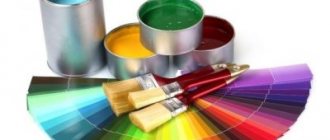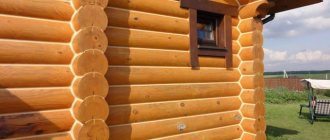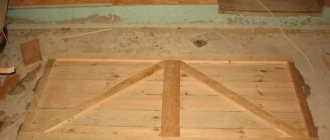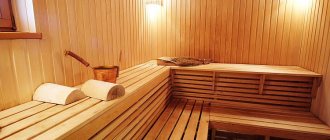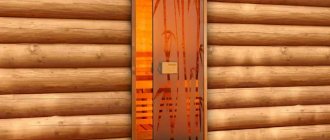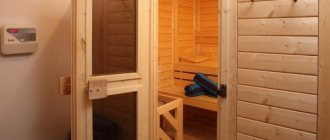Wooden doors
Wooden doors look aesthetically pleasing and elegant. There are many opportunities to buy blanks for painting or varnishing. It's cheap and practical. You can paint the old product in the desired tone that matches the interior. Many people wonder what is used to cover solid wood doors. There are many upgrade options. The only thing that is necessary is to adhere to the technology of preparing the canvas and painting.
Solid pine surface covered with enamel
Advantages and features of using varnish
The varnish gives the canvas a spectacular appearance and enhances the protective functions of the wood.
With the help of varnish, wood rotting is prevented, and the apartment or house becomes more comfortable. To cover interior wooden doors, you can use several types of varnish. In this case, the canvas can be made of pine and other types of wood. Due to this technique, the shade inherent in the door leaf is emphasized. The covering material gives some door parts a rich and deep color.
Varnish - an affordable universal product for coating wood
To varnish wood, it is recommended to choose the right product. Impregnations protect wood from mold and rot. Protective agents do not allow the fabric to swell. They also protect the box from the sun and sudden temperature changes.
Before varnishing wooden doors, let’s get acquainted with the advantages of this finishing method:
- accessibility – the buyer is given the opportunity to buy varnish taking into account the price factor. At the same time, experts advise treating the canvas with a mixture that can improve the external and protective properties, extending the service life of the canvas;
- easy updating - anyone can paint the door, including those new to such work;
- versatility - the varnish is used for different surfaces;
- varnish helps to increase the fabric’s resistance to various negative influences, which include scratches, moisture, and mechanical damage.
Water-based varnishes are odorless.
All varnishes are classified into the following types based on their composition:
- oil based – they are based on oils that are well absorbed into the surface, changing its color. They are used as a solvent. Such compositions take a long time to dry. They have an unpleasant odor;
- aqueous - colorless and without a pungent odor, matte or glossy type. They dry out quickly. But stain is used first.
What to look for when choosing?
The first step is to decide for which door the material is being purchased. If this is an interior room, you should give preference to acrylic compositions. For the entrance, you can use alkyd varnish. Humidity also matters. For the bathroom you need to buy moisture-resistant products.
You need to decide what kind of coating you want - matte or glossy. The latter will highlight all the irregularities. Therefore, if there are defects in the coating, it is better to choose a matte varnish for the doors.
Before applying the material to the door, it is recommended to test it on an inconspicuous place. Without experience, you can leave noticeable stains on the surface.
Painting a door step by step
In a specialized store you can find many different paints and varnishes. As a rule, buyers focus on color when choosing, but there are other characteristics that must be taken into account. Only in this case will you get the expected result.
When choosing what to paint interior wooden doors with, you should find out about the accepted classification:
- depending on the composition, paints are organic or water-based;
- according to the method of use they are divided into combined, external, internal;
- depending on the protective effect, the products can withstand chemicals, temperature fluctuations, humidity, and mechanical stress;
- depending on the type - impregnations, stains, paints, varnishes.
Having figured out how to cover a wooden door, you can proceed directly to the painting process.
Let's look at it step by step:
- Preparatory stage. Before painting wooden interior doors, they need to be removed from their hinges, laid on a stable and durable horizontal surface, and the fittings removed. If the latter is problematic, then you can wrap all the elements in foil and seal the locks with tape.
- Removing old finishes. When the canvas is ready for processing, the previous layer should be removed. For example, before repainting a varnished wooden door, you need to clean it and remove the old coating. It is best to take a grinding machine, which will work much faster than by hand. If there is none, you can use coarse sandpaper. If bubbles appear, a hair dryer will help. It will heat up the paint layer, and all you have to do is remove it with a spatula. You can also remove the old coating using an abrasive attachment on a drill. After finishing the work, it is necessary to sweep away all debris from the surface and grind. If the canvas requires reinforcements, then before painting the wooden door, you need to install them.
- Putty and sanding. If there are cracks, depressions, or unevenness on the surface of the canvas, they should be thoroughly filled with putty. It is best to choose a mixture of the same tone with the door structure, so that there are no problems with subsequent paint application. When the mixture dries, you need to walk over the sealed areas with fine-grained sandpaper to level the surface.
- Antiseptic coating. This stage is necessary for structures installed in rooms with high humidity. The antiseptic will protect the product from the formation of fungi and mold. The composition is applied before painting interior wooden doors. It is better if both this mixture and the paint are from the same company. When the antiseptic has dried, cover the surface with a primer, and then go over the entire door with putty. It is necessary to apply two layers: the second - after the first has completely dried.
- Coloring. Many people are interested in how to properly paint wooden doors? It is not difficult to restore the beautiful appearance of the structure on your own. You should not buy a spray bottle if you need to treat one or two systems. A roller or brush will do just fine. Before you paint a wooden door with your own hands, you need to thoroughly fluff the brush and remove loose hairs. It is best to paint a panel door with a roller. The process will take three stages, you should start from the upper left corner, gradually moving to the right, processing the entire surface of the door. When the first layer has dried, we re-paint the canvas longitudinally. The third stage is processing, starting from the upper right corner. As you can see, painting a wooden door correctly is not difficult and it does not take much time.
We suggest you read: What to do if the door is warped.
A brush is suitable for painting solid pine doors with your own hands. You need to move smoothly and confidently, avoiding applying too much composition. Particular attention must be paid to the corners: paint should not accumulate in them.
Do-it-yourself painting of wooden doors with alkyd enamel is done in a horizontal position. If the structure contains glass elements, they must be sealed with tape or film. If the product has decorative paneled elements, they are painted first. To make the material adhere better, you can dilute the composition with liquid soap for the first layer. Apply clean paint with the second ball.
If you are covering the door with stain, then you do not need to apply a primer before painting a wooden pine door. This product penetrates the material quite deeply, creating high-quality protection against negative factors. The composition can be applied in the traditional way, or by rubbing and spraying.
Recommendations
To avoid damaging the door handles during varnishing, it is advisable to wrap them with masking tape. It is not recommended to use regular one, as it leaves traces of glue. But the paper one is perfect. But, if it is necessary to process all hidden places, it is advisable to disassemble the fittings.
It is also recommended to completely remove the old protective coating before applying a new coat of varnish. This will not only have a positive effect on the appearance, but will also extend the life of the protective surface. Don't forget about safety precautions. Experts recommend working with protective gloves. And if it is an interior door, it is important to ventilate the room well (even if it is acrylic varnish).
Materials and tools
When deciding what paint to paint a wooden door in an apartment, let's look at the main types that are preferable for this type of structure.
Paints
Paint for wooden interior doors is considered the best option. It is suitable for finishing both new and worn-out fabrics. In principle, choosing it will not be difficult.
You should pay attention to thickness and density: there are compositions that are applied in 1-2 layers, and the color turns out saturated. And there are those that remain transparent, and in order to add the desired shade, you will need to apply at least 5 layers.
Alkyd enamel is the most popular paint for wooden doors, which is also affordable. The downside of the composition is the strong pungent odor. It will take several days to weather it. This is unacceptable in a residential area. Therefore, as an alternative, you can use acrylic enamel. This odorless paint is an excellent option for wooden interior doors.
Nitro paint is considered the most durable. But painting wooden doors at home with this composition will not work, since it is very toxic. When working with it, it is important to protect your face and hands with special means.
We suggest you read: At what distance to drill piles for the foundation
These materials are used to give wood a well-groomed appearance, shine and strength. If you are looking for something to cover a wooden door indoors, such compositions are an excellent option. It is advisable to use them in rooms with a high degree of humidity, for example, in a bathroom, sauna, shower.
The following types of varnishes are popular:
- odorless acrylic - makes the surface of the wood matte or glossy, protects against excessive humidity and ultraviolet radiation;
- water-based – odorless;
- nitrocellulose - chosen to repaint wooden doors in rooms with moderate humidity;
- with fatty resins - very thick consistency;
- polyurethane - creates a matte, glossy, semi-glossy effect on the surface, grips well, protects the wood;
- polyester – has a strong odor, very durable, used for entrance structures.
If you are looking for something to paint a solid pine door with, pay attention to polyurethane or acrylic varnish.
Stains
This material is used as temporary protection for the canvas, as well as for tinting the surface. Stain emphasizes the structure of the wood, but it must be frequently renewed in order for the structure to have an aesthetic appearance.
Today there are the following types of stains:
- Water based. It has no toxic odor, dries for a long time, penetrates deep into the wood, creating a beautiful shade.
- On a varnish base. It dries quickly, but does not give such a decorative effect as other types. To improve the color of wooden doors, you can resort to spraying with a spray gun.
- Oil based. Before painting it is diluted with a solvent, it is economical.
- For alcohol. It has a strong smell, dries quickly, and is quite expensive.
To update a door, you can use several types of coatings. Alkyd varnishes contain solvents that give the wood a yellow tone and resistance to moisture.
To improve drying ability, increasing moisture resistance and strength, hardeners are added to the mixture. The surface coated with this product dries within 24 hours.
Alkyd varnishes make wood moisture resistant.
You can impregnate wood with acrylic varnishes, which are made from water. They are non-toxic and odorless. To increase strength, hardeners are added to their composition.
We invite you to read: Height of strip foundation for a house
You can update a room decorated with wood using nitro varnishes. Their main advantage is quick drying. They are based on solvents. One of the disadvantages is increased toxicity, so nitro varnishes are rarely used.
Polyurethane coatings are characterized by increased strength. Due to polyurethane, the wood is given a dark shade, so the surface of the canvas is primed.
Tools for varnishing a door
To carry out preparatory work followed by varnishing the surface with your own hands, you will need the following tools:
- roller or brush;
- rags;
- putty knife;
- wood putty;
- Grinder;
- sandpaper;
- construction hairdryer
Surface varnishing
After opening the jar with the composition, before covering the door with varnish, slowly stir it. This condition is fundamentally important, since only with slow stirring will air bubbles not form. Pour a small amount of the composition into the bath, after securing the door horizontally. With the frame, obviously, everything is more complicated, which is why there are drips when painting it.
To ensure that the transitions between layers are imperceptible, it is important to apply the varnish quickly. The layers are applied in an overlapping direction and there must be at least 3 of them. Before applying the next layer, you need to make sure that the previous layer is completely dry. Varnishes have different drying speeds, so read the instructions to find out how quickly the composition you purchased dries.
As for the panels, in most cases they are varnished with a small brush. Streaks, sagging and stains are removed with sandpaper, with the exception of the top layer. While the varnish layer dries, you can store the roller or brush in a jar of varnish or a well-wrapped bag.
When varnishing, many craftsmen do not remove the handles, but simply wrap them up, despite the fact that this effect is incorrect. This is explained by the fact that the areas under the handles must also be covered with impregnation and primer.
So, if you follow the simple tips mentioned above, varnishing the door will go smoothly and in a short time. Perhaps you have questions on the topic or some comments about the article. We look forward to your comments.
Painting a door step by step
Before coating the door with paint and varnish, the door is sanded - roughness and unevenness are removed. The thicker the box, the longer the grinding process. One sanding option is to use a board (25x10 cm) wrapped in sandpaper. You can also do this job using a sander.
To eliminate surface defects, the wooden door is sanded.
All defects are sealed with putty, the choice of which takes into account the color. After cleaning, the inner box is treated with impregnation - protection against mold and pests.
To improve the quality of varnish and reduce varnish consumption, the coating is primed with a roller or brush. Dust is removed from the canvas, and the coating itself is degreased with white spirit.
Summary
If you decide that wood will be the finishing material for your interior, there is no need to be afraid of monotony and boredom. Modern solutions offered by wood stains make it possible to bring out many of the original colors, while maintaining the natural appearance of the raw material.
After reading this article, you can learn everything about coloring yourself and try to do it yourself. With all the information gathered, you can learn which stain to choose for which type of wood, how to prepare the surface before application, and even step-by-step how to create your painted products. You know the technique, the rest is a matter of imagination.
Making an antique effect
Antique doors highlight the design solutions in the room. To update the interior of the house in this way, an “antique” wooden door is created. Several technologies are used for this:
- Brushing is a simple technique that is used by many craftsmen. The work is done with an iron brush, with which the top layer of wood is removed (until the annual rings appear). But this technique of giving the door an antique look requires a large amount of varnish;
When brushing, the top layer is removed with a wire brush. - patina - “patina” is a special paint that is often used to create the effect in question. The technology for applying the mixture consists of choosing the desired color and applying 1 main layer, which is subsequently covered with paints or varnishes, but of a lighter shade. If the surface is dry, fine-grained sandpaper is used to make it look antique. The bottom layer, which appears through the top, creates the effect of numerous paintings. “Natural scratches” can be seen on the canvas;
Patching gives the wood the effect of multiple paintings - aging with wax - to perform this technology, you will need to follow a certain sequence: applying wax - painting in a lighter tone. After complete drying, the paraffin is removed. A spatula is used for this. Then the base is sanded. Varnish or stain is applied. The door is treated with wax. It is this technology that allows you to create a “antique” appearance that is as close to the truth as possible.
Tags: door, wooden, cover, pine
« Previous entry
Step-by-step staining of wood
Painting wood with stain seems like a no-brainer. The substance upon first contact is so fluid that it easily spreads over the material and also dries quickly. Unfortunately, the job can quickly become difficult if the results do not meet the contractor's expectations.
What can happen if stain is applied incorrectly?
- stripes,
- color change;
- unevenly distributed color,
- different shades of color on furniture, doors or ceilings that do not look aesthetically pleasing.
To avoid failure and disappointment due to a failed dyeing attempt, it is important to know how to properly prepare the material before dyeing. This is very important in the dyeing process. In fact, painting a surface is just a pleasure if you prepare the “foundation” correctly.
To get the desired coloring effect, you first need to:
- sand the surface along the grain, getting rid of all irregularities or possible contaminants (residues of varnish, resin, protruding units and rings);
- thoroughly wiping the surface with a broom, brush or vacuum cleaner (especially for large surfaces);
- filling defects in the material with wood putty (this action is necessary if you want to get a smooth end surface, for example, on stairs or furniture).
How to apply stain?
It seems that a brush will be the most convenient, but is it for everyone? It's worth knowing which brush to choose to avoid problems during application.
If you want to paint a large surface of material, such as doors, pallets, structural elements of buildings, you can apply the stain using a painting unit. For small surfaces such as veneer or small plaster parts, a sponge or cloth will do.
Correct coloring step by step
If the material to be painted is properly prepared, the substance can be applied correctly:
- Before use, mix the stain thoroughly in the jar;
- Exotic wood should be cleaned with trichlorethylene (TCE) or a 10% solution of water and ammonia;
- The stain should be applied along the grain, evenly and in thin layers. It is advisable to move your hand evenly and apply the same force so that the color is distributed evenly;
- Immediately remove excess stain with a dry brush or wipe off with a soft cloth.
You can be an enthusiast, a handyman or a hobbyist with a passion for carpentry to take advantage of all the possibilities that wood stain offers. Experience in using the drug comes with time, and there is no doubt that the effect will be better each time.
Stain is widely used not only in construction and carpentry, but also in decorative techniques and renovation processes. Its wide range of colors allows you to match the color to the interior and functionality, so it can be used in many processes related to wood processing. Wood stain is a favorite of decorators and artists for whom wood is an interesting finishing material.
How to remove old paint?
To soften the previous layers of paint, you can apply a chemical stripping layer and let it soak into the surface. This work may take about 2 hours. After a while, the old paint will begin to bubble and come away from the door. It can be thoroughly removed with a spatula until the canvas is completely clean.
Also, to remove the old paint, you can heat it up with a hair dryer and remove it with a spatula. While the finish is well heated, it remains as soft as possible and is much easier to remove.
You can use both of these methods. This method is especially often used to clean oil paint applied in many layers.
You can degrease a wooden door with a metal brush and fine or coarse sandpaper. In particularly difficult cases, a plane or aggressive chemical compounds are used. Plastic models are degreased with acetone and white spirit.
Preparing the door covering
Well, let's figure it out further, how to paint a door correctly? Preparatory work is carried out according to the following scheme:
- Remove all old coating, even primer and putty, until the wood itself remains. For this work, you can use a grinder, a hair dryer, or special cleaning compounds.
- Then you need to sand the surface, remove any defects, sand off small paint residues, and degrease. This work cannot be done without a sander, which is best connected to a vacuum cleaner. If you don’t have such a device, you can get by with medium-grain sandpaper.
Plastering a door
- When you have completely managed to sand the canvas and prime it, you can move on to puttying large flaws. If you plan to use varnish as a finishing coat, it is better to use a special composition for wood. If the decorative dye is not transparent, you don’t have to worry about the color of the putty. Don't forget about the gaps at the walls and baseboards!
- After puttying, after waiting the time specified by the manufacturer of the mixture, you need to sand again, masking the abrasions. You can immediately use a medium-grained cloth, and then finish with a fine-abrasive one.
If the doors under the old finishing materials have darkened, and you would like to simply open them with varnish, preserving the structure and pattern of the wood, problem areas can be lightened. To do this, you can prepare a simple bleach with your own hands: mix bleach with water in a ratio of 1:3. When the surface is completely processed, wiped with a rag and dried (so that the paint does not begin to swell), you can begin directly painting the door.
Original room interior design options
Doors in a loft style interior can be painted in both pastel and dark shades. Solid black canvases in such ensembles will also look good, especially if they are installed against a background of neutral-colored laminate and walls finished with decorative bricks.
Doors in Provence style should not be too dark and gloomy. On such canvases, milky, beige, cream or ivory paint will look best. Such designs should echo the soft and delicate colors of the good-natured Provençal style.
Doors in classic ensembles can also be painted in dark or light colors. The main thing is to rely on the basic palette of the interior. For example, in a room with soft peach walls, a milky door decorated with orange stencil patterns will look organic. In more subdued settings, made in chocolate or caramel tones, doors painted in dense dark brown shades will look organic.
Fans of bright solutions can paint indoor doors in the most unexpected and rich colors. For example, in a room with muted blue-gray walls and a dark brown floor, a yellow door will act as a bright accent.
However, the colors don't have to be in marked contrast to each other to create an original and fresh ensemble. So, a simple wooden door painted a deep blue will look attractive in a room with dull blue walls and dark blue curtains. In such conditions, a bright door will enliven the entire ensemble and will organically stand out against its background.
A door located in a bright room with bright furniture can be repainted a neutral gray color. For example, it may have white walls, a brown laminate floor and a red leather seating area. It is not recommended to install such canvases in interiors of a similar shade.
Blue door leaves will also look impressive in snow-white rooms. This combination is especially appropriate in a marine style. If you complete the space with a striped chair and decorative elements in the form of boats and “treasure maps,” the ensemble will turn out to be very interesting and original.
In a room with coffee-colored walls and a dark floor, you can install a tall wooden door painted in a deep turquoise color. This colorful combination will look unusual and cozy.
A canvas covered with white paint will look organic in almost any interior. It can be either a dark or a snow-white room. In the second case, you can avoid merging the canvas with the decoration using an accent wall.
In this video you will find step-by-step instructions for painting a door.
Tags: door, interior, stain
« Previous entry
